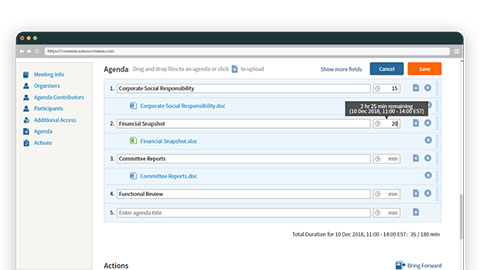In the late 1990s, the Internet was already quickly becoming mainstream. People were buying personal computers, availing the services of ISPs, and going online to explore what the World Wide Web had to offer.
By then, forward-thinking directors were starting to think of ways to use the Internet for digitizing the board meeting process even if technology was limited. It would take until after the new millennium before the electronic board portal — referring to both the technology and the term — was formally introduced in the market.
Online Storage for Boards
Preceding the board portal was the “electronic board book” which, in effect, was nothing more than an online storage for board meeting materials. It didn’t do much in terms of facilitating collaboration or administering board meetings, but it revealed that there was a significant market for software that could fully digitize the board meeting process. It was enough to lay the foundation for electronic solutions such as the board portal.
Main Cause of the Electronic Board Portal
Inevitably, what kickstarted the rise of electronic board portals would be the corporate financial scandals that happened during the early 2000s.
Beyond electricity and natural gas, Enron branched out to the communications and paper and pulp industries. By 2000, it had around 20,000 employees on its payroll and $101 billion in revenue. It hit a record high of $90 per share, and Fortune magazine even named it “America’s Most Innovative Company” for six straight years. At the time, Enron seemed like it would continue to reach record profits at the turn of the century. However, by December 2001, Enron was discovered to be involved in a well-planned and equally well-executed accounting fraud. The energy giant would implode and file bankruptcy, leaving employees with no jobs, and investors with major losses.
The Securities and Exchange Commission (SEC) started an investigation, causing Enron officials to admit that they exaggerated company earnings to attract investors.
Corporate Regulations and Compliance
Aside from Enron, other companies such as WorldCom, Adelphia, and Tyco International also got involved in financial scandals. In response to these breaches in business ethics, a new U.S. federal law was introduced, the Sarbanes-Oxley Act of 2002. Named after Sen. Paul Sarbanes and Rep. Michael G. Oxley, two U.S. lawmakers who co-sponsored the act, the law requires public companies and accounting firms to adhere to stricter standards when making corporate disclosures, such as earnings and losses.
Even though this was just a U.S. law, the effects were felt worldwide since many multinational corporations were headquartered in the United States. Foreign companies who had to do business in the country were also required to comply. These laws and regulations necessitated the use of a software that would be able to adhere to these new compliance requirements.
Early Kinds of Electric Portal for Boards
The development of new technology and the rise of corporate scandals amplified the need for a more efficient board meeting process that would make board meetings not only convenient, but also compliant. In 2002, BoardVantage was one of the early providers. The company received VC funding along with others offering similar services.
However, the market for the electronic board book (the term ‘board portal’ didn’t exist yet) was still a niche. Only the C-suite crowd had use for it, and even then, its functionality as limited to accessing meeting documents on bulky laptops. There wasn’t much that could be done with it.
It would take three more years, in 2005, before the electronic board portal as we know it became a well-defined category in the market. It took time for technology to develop and corporate boards to warm up to the idea.
Rise of Electronic Board Portal Providers
What started out as a simple storage for meeting documents back in 2002 evolved into a comprehensive board portal solution a decade after. Although BoardVantage was a pioneer, major players like Diligent, BoardPad, and Convene entered the picture later on to improve on the electronic board portal.
In 2000, AIG SunAmerica wanted a web-based system that streamlined and centralized the delivery of board meeting materials. They wanted the system to be easy, flexible, and easy to use. More importantly, they wanted it to be secure.
Diligent BoardBooks responded to AIG SunAmerica’s need. As a result, the concept behind Diligent BoardBooks was launched.
BoardVantage, too, was among the first providers of electronic board books in the early 2000s, having received VC funding in late 2002. But as was mentioned in the previous article, these electronic board books served as secure storage for meeting materials, and not much more. They enabled board members to do away with heavy board packs, but the rest of the board meeting process remained more or less the same.
Back then, the common solution for organizations that wanted to go electronic was to make their own electronic board book on their IT infrastructure. There was a lack of demand, and therefore, a lack of providers, so organizations didn’t have much choice in the matter. Back then, electronic board books existed mainly as a passive tool that board members accessed to download or upload their meeting files as needed. And for a while, that was enough.
Growth of Sophisticated Electronic Portals
But as technology got better and corporate governance got stricter, it became more apparent that a system for the board meeting process needed to be developed. The Sarbanes-Oxley Act of 2002 required organizations to be more transparent in their reporting, so there was the need to document everything. Hence, another stage of the electronic and online board portal evolution. This was around 2005, when the term “board portal” finally came into existence.
Instead of just focusing solely on the needs of board members, electronic portals addressed the needs of corporate secretaries, too. Scheduling board meetings, sending out invitations, preparing board packs, taking down minutes of the meeting, and other tasks became doable on these electronic board portals.
Organizations were gravitating towards providers as well. True Value, an American chain of hardware retail stores, tried to create their own in-system electronic board portal, only to have their board members say that the system developed for the company was too hard to use. True Value, in the end, opted for the services of a board portal provider.
Around this time, more IT providers started offering their own electronic portals for boards: BoardEffect, Aprio, and BoardPad were just a few.
But the real game-changer was the iPad, which was first released in 2010. Instead of bulky laptops, board members could use these handy tablets in board meetings. For the first time, board members were truly mobile, making it possible for them to work with one another wherever they might be. With its multi-touch capability, users could also write and draw directly on the iPad, just like on a paper, breaking down barriers even further.
These attributes paved the way for more features that induced better collaboration among board members. Finally, the technology needed for remote board meetings already existed, and providers were quick to realize that.
New Generation of a Electronic Board Portal
Among the members of the new generation of the board portal market is Convene, launched in 2012. Although it competes with established names in the industry, the timing of Convene couldn’t be more perfect. It entered the market just when cloud computing and mobile devices were taking off, so it was able to harness these technologies to become the comprehensive electronic board portal solution it is now.
Compared to other competitors, Convene had never before seen multi-platform capability and worked efficiently on iPads, iPhones, Android, and Windows devices. It was also backed by a secure web portal hosted either on Amazon Web Services or the users’ own in-system servers.
Finally, Convene‘s electronic board portal focused on enhancing collaboration and productivity among board members. Features such as live presentation tools, shared annotations, page synchronization, and live voting allowed board directors to do all their responsibilities within the electronic software.
Convene ultimately led the charge on the latest generation of electronic board portals by providing more customizability in terms of user interface, security features, and hosting options.
From mere file servers to comprehensive solutions, the electronic board portal has, indeed, come a long way. It is currently unknown what the future of board portals will look like. It really all depends on the technology that will be developed in the next few years.
—
Among the many solutions available in the market today, Convene is the award-winning electronic board portal solution that efficiently optimizes the board meeting process. Convene is developed by Azeus Systems, a CMMI Level 5 Company and is trusted by top organizations across the world including Tesco PLC, Fidelity International, London Metal Exchange, Mizuho Securities, and Emaar Hospitality Group LLC.
Nina is a Digital Marketing Manager of the global marketing team at Convene. She has profound knowledge of the growing trends within the board management software market. With her ample experience in marketing and corporate solutions, she authors in-depth articles that teach companies about the features and benefits of board portals.










